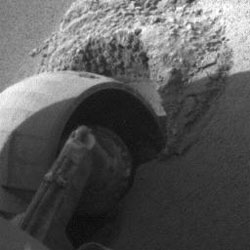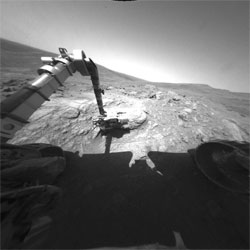
Spaceflight Now +

|

|

|

|

Premium video content for our Spaceflight Now Plus subscribers.

Voyager adventures
 This animation shows the Voyager spacecraft heading into the solar system's final frontier and the edge of interstellar space. (1min 24sec file) This animation shows the Voyager spacecraft heading into the solar system's final frontier and the edge of interstellar space. (1min 24sec file)
 Play video Play video

Mike Griffin at KSC
 NASA Administrator Mike Griffin and Kennedy Space Center Director Jim Kennedy chat with reporters at the Cape on a wide range of topics. The press event was held during Griffin's tour of the spaceport. (27min 48sec file) NASA Administrator Mike Griffin and Kennedy Space Center Director Jim Kennedy chat with reporters at the Cape on a wide range of topics. The press event was held during Griffin's tour of the spaceport. (27min 48sec file)
 Play video Play video

Delta rocket blasts off
 The NOAA-N weather satellite is launched aboard a Boeing Delta 2 rocket from Vandenberg Air Force Base, California. The NOAA-N weather satellite is launched aboard a Boeing Delta 2 rocket from Vandenberg Air Force Base, California.

 Play video: Play video:
Liftoff | Extended clip
Umbilicals | IR tracker

NOAA pre-launch
 Officials from NASA, NOAA, the Air Force and Boeing hold the pre-launch news conference at Vandenberg Air Force Base to preview the mission of a Delta 2 rocket and the NOAA-N weather satellite. (29min 54sec file) Officials from NASA, NOAA, the Air Force and Boeing hold the pre-launch news conference at Vandenberg Air Force Base to preview the mission of a Delta 2 rocket and the NOAA-N weather satellite. (29min 54sec file)

 Play video: Play video:
Dial-up | Broadband

Countdown culmination
 Watch shuttle Discovery's countdown dress rehearsal that ends with a simulated main engine shutdown and post-abort safing practice. (13min 19sec file) Watch shuttle Discovery's countdown dress rehearsal that ends with a simulated main engine shutdown and post-abort safing practice. (13min 19sec file)
 Play video Play video

Going to the pad
 The five-man, two-woman astronaut crew departs the Operations and Checkout Building to board the AstroVan for the ride to launch pad 39B during the Terminal Countdown Demonstration Test countdown dress rehearsal. (3min 07sec file) The five-man, two-woman astronaut crew departs the Operations and Checkout Building to board the AstroVan for the ride to launch pad 39B during the Terminal Countdown Demonstration Test countdown dress rehearsal. (3min 07sec file)
 Play video Play video

Suiting up
 After breakfast, the astronauts don their launch and entry partial pressure suits before heading to the pad. (3min 14sec file) After breakfast, the astronauts don their launch and entry partial pressure suits before heading to the pad. (3min 14sec file)
 Play video Play video

Astronaut breakfast
 Dressed in festive Hawaiian shirts, Discovery's seven astronauts are gathered around the dining room table in crew quarters for breakfast. They were awakened at 6:05 a.m. EDT to begin the launch day dress rehearsal at Kennedy Space Center. (1min 57sec file) Dressed in festive Hawaiian shirts, Discovery's seven astronauts are gathered around the dining room table in crew quarters for breakfast. They were awakened at 6:05 a.m. EDT to begin the launch day dress rehearsal at Kennedy Space Center. (1min 57sec file)
 Play video Play video

Training at KSC
 As part of their training at Kennedy Space Center, the Discovery astronauts learn to drive an armored tank that would be used to escape the launch pad and receive briefings on the escape baskets on the pad 39B tower. (5min 19sec file) As part of their training at Kennedy Space Center, the Discovery astronauts learn to drive an armored tank that would be used to escape the launch pad and receive briefings on the escape baskets on the pad 39B tower. (5min 19sec file)
 Play video Play video

Discovery's crew
 Shuttle Discovery's astronauts pause their training at launch pad 39B to hold an informal news conference near the emergency evacuation bunker. (26min 11sec file) Shuttle Discovery's astronauts pause their training at launch pad 39B to hold an informal news conference near the emergency evacuation bunker. (26min 11sec file)

 Play video: Play video:
Dial-up | Broadband

Astronaut Hall of Fame
 The 2005 class of Gordon Fullerton, Joe Allen and Bruce McCandless is inducted into the U.S. Astronaut Hall of Fame at the Saturn 5 Center on April 30. (1hr 24min 55sec file) The 2005 class of Gordon Fullerton, Joe Allen and Bruce McCandless is inducted into the U.S. Astronaut Hall of Fame at the Saturn 5 Center on April 30. (1hr 24min 55sec file)
 Play video Play video

'Salute to Titan'
 This video by Lockheed Martin relives the storied history of the Titan rocket family over the past five decades. (4min 21sec file) This video by Lockheed Martin relives the storied history of the Titan rocket family over the past five decades. (4min 21sec file)
 Play video Play video

Titan history
 Footage from that various Titan rocket launches from the 1950s to today is compiled into this movie. (6min 52sec file) Footage from that various Titan rocket launches from the 1950s to today is compiled into this movie. (6min 52sec file)
 Play video Play video

 Become a subscriber Become a subscriber
 More video More video

|

|

|

|
|

|

Martian rover missions experience highs and lows
NASA/JPL STATUS REPORT
Posted: May 24, 2005
NASA's Mars rover Opportunity is trying to escape from a sand trap, while its twin, Spirit, has been busy finding new clues to a wet and violent early Martian history.
| |

The left front wheel of NASA's Mars Exploration Rover Opportunity makes slow but steady progress through soft dune material. Credit:
NASA/JPL
|
"Spirit has finally found the kind of geology you can really sink your teeth into," said Dr. Steve Squyres of Cornell University, Ithaca, N.Y. He is principal investigator for the Mars rovers' science instruments. According to Squyres, multiple layers of rock in the hills Spirit is exploring suggest successive deposits of water-altered explosive debris.
Spirit, inside Mars' Gusev Crater, had to share the spotlight with the drama provided by Opportunity on the Martian Meridiani plains. The rover has been hindered by soft sand for nearly three weeks. Traction is difficult in the ripple-shaped dune of windblown dust and sand Opportunity drove into on April 26. Since it began trying to get out, the rover has advanced only 11 inches. Without the slippage caused by the rover's wheels spinning in the soft sand, Opportunity could have driven 157 feet.
"If Opportunity gets free, its next task will be examining the site to give the rover team a better understanding of how this ripple differs from dozens Opportunity easily crossed," said Jim Erickson. He is project manager for the Mars Exploration Rover Project at NASA's Jet Propulsion Laboratory, Pasadena, Calif.
The rovers have worked under harsh Martian conditions longer than expected. They have been studying geology on opposite sides of Mars for more than a year since successfully completing their three-month primary missions. Shortly after landing in January 2004, Opportunity found layered bedrock bearing geological evidence of a shallow ancient sea. More than one year later, Spirit found extensive layered bedrock, after driving more than two miles and climbing into the "Columbia Hills."
Squyres said, "In the last few weeks, we have gone from a state of confusion about the geology of the Columbia Hills to having real stratigraphic sequence and a powerful working hypothesis for the history of these layers."
| |

Spirit moves its robotic arm, called the instrument deployment device, to take a series of images with the rover's microscopic imager of this rock target, dubbed "Keystone," at an outcrop called "Methuselah." Credit: NASA/JPL
|
For several months, Spirit climbed a flank of Husband Hill, the tallest in the range. The slope closely matched the angle of underlying rock layers, which made the layering difficult to detect. Spirit reached an intermediate destination, dubbed "Larry's Lookout," then continued uphill and looked back. "That was the critical moment, when it all began falling into place," Squyres said. "Looking back downhill, you can see the layering, and it suddenly starts to makes sense."
Spirit has been examining rocks in a series of outcrops called Methuselah, Jibsheet and Larry's Lookout. Some of the rocks contain the mineral Ilmenite, not found previously by Spirit. "Ilmenite is a titanium-iron oxide formed during crystallization of magma," said Dr. Dick Morris, a rover science-team member at NASA's Johnson Space Center, Houston. "Its occurrence is evidence for diversity in the volcanic rocks in the Gusev region."
Rocks from different layers share compositional traits, high in titanium, and low in chromium, which suggests a shared origin. However, the degree to which minerals in rocks have been chemically altered by exposure to water or other processes varies greatly from outcrop to outcrop. The textures also vary. At Methuselah, rocks have thin laminations revealed by Spirit's microscopic imager. At Jibsheet, they are built of bulbous grains packed together. At Larry's Lookout, the rocks are massive, with little fine-scale structure.
"Our best hypothesis is we're looking at a stack of ash or debris that was explosively erupted from volcanoes and settled down in different ways," Squyres said. "We can't fully rule out the possibility the debris was generated in impact explosions instead of volcanic ones. But we can say, once upon a time, Gusev was a pretty violent place. Big, explosive events were happening, and there was a lot of water around," he explained.
Rover-team scientists described the robot explorers' activities today at the spring meetings of the American Geophysical Union in New Orleans.
|

|

|

|


|



